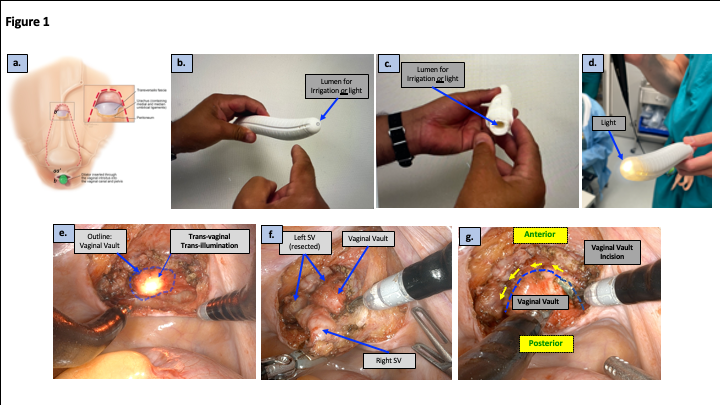Back
Introduction: A morbid complication of gender affirming vaginoplasty surgery is loss neovaginal canal depth. Options to restore depth are limited. Some surgeons describe increasing depth by opening the fore-shortened vaginal canal into the pelvis and then gathering peritoneum adherent to the bladder and rectum together to enclose the vaginal canal opening into pelvis. Two principal disadvantages of this technique are that: 1. The rectum is, by necessity, incorporated as a wall of the vaginal canal; and 2. The gathering sutures remain to tension, especially during rectal filling. We describe a novel alternative technique that utilizes peritoneum from the urachus and anterior bladder dome to restore vaginal length, and show that it can be easily performed via a dual approach using a single-port robot-assisted and trans-vaginal technique. We also highlight technical innovations we developed.
Methods: From a view optimized by the Lap SP camera, we identify the location of the remnant vaginal canal vault, and incise the peritoneum horizontally over a dilator in the canal space. Anterior vaginal canal is anastomosed to peritoneum anterior to the incision, and the peri-umbilical end of our flap (Figure 1a) is anastomosed to the posterior edge. Our flap completely anteriorly based (uses a 3-layer flap of peritoneum, urachus and Transversalis fascia, from the umbilicus to the anterior bladder dome), and completely excludes the rectum. Our tubularized flap suture-lines are subject to tension only during filling of the vaginal canal, and has no sutures at the vault-end.
Results: (See video) Our novel technical innovations not described in the literature for peritoneal vaginoplasty include: 1. Design of a novel hollow vaginal dilator for intra-op (lighted transillumination) and post-op use (dilation/douching) (b-d); 2. Vaginal insertion of our lighted dilator to confirm location of the remnant vaginal-vault (e); 3. Excision of the Seminal vesicles to un-obstruct the canal space (f); and 4. A spatulated/offset anterior/posterior vaginal-peritoneal anastomosis.(g
Conclusions: Our flap is based on anatomy quite familiar to the urologic surgeon: the urachus. It is technically simple to perform, and our innovations render it safer with better outcomes. Clinical outcomes presented in: Smith, Garcia, et al, Sex. Med., 2022 SOURCE OF
Funding: None

Video Abstract Session
Session: V09: Reconstruction/Transgender
V09-06: Single-Port Robot-Assisted Tubularized Urachus-Peritoneal Hinge-Flap Salvage Gender-Affirming Vaginoplasty
Sunday, April 30, 2023
10:20 AM – 10:30 AM CST
Location: Video Abstract Theater
- MG
Maurice Marcel Garcia, MD, MS (he/him/his)
MD, MAS
Cedars-Sinai Medical Center, Los Angeles
Video Presenter(s)
Introduction: A morbid complication of gender affirming vaginoplasty surgery is loss neovaginal canal depth. Options to restore depth are limited. Some surgeons describe increasing depth by opening the fore-shortened vaginal canal into the pelvis and then gathering peritoneum adherent to the bladder and rectum together to enclose the vaginal canal opening into pelvis. Two principal disadvantages of this technique are that: 1. The rectum is, by necessity, incorporated as a wall of the vaginal canal; and 2. The gathering sutures remain to tension, especially during rectal filling. We describe a novel alternative technique that utilizes peritoneum from the urachus and anterior bladder dome to restore vaginal length, and show that it can be easily performed via a dual approach using a single-port robot-assisted and trans-vaginal technique. We also highlight technical innovations we developed.
Methods: From a view optimized by the Lap SP camera, we identify the location of the remnant vaginal canal vault, and incise the peritoneum horizontally over a dilator in the canal space. Anterior vaginal canal is anastomosed to peritoneum anterior to the incision, and the peri-umbilical end of our flap (Figure 1a) is anastomosed to the posterior edge. Our flap completely anteriorly based (uses a 3-layer flap of peritoneum, urachus and Transversalis fascia, from the umbilicus to the anterior bladder dome), and completely excludes the rectum. Our tubularized flap suture-lines are subject to tension only during filling of the vaginal canal, and has no sutures at the vault-end.
Results: (See video) Our novel technical innovations not described in the literature for peritoneal vaginoplasty include: 1. Design of a novel hollow vaginal dilator for intra-op (lighted transillumination) and post-op use (dilation/douching) (b-d); 2. Vaginal insertion of our lighted dilator to confirm location of the remnant vaginal-vault (e); 3. Excision of the Seminal vesicles to un-obstruct the canal space (f); and 4. A spatulated/offset anterior/posterior vaginal-peritoneal anastomosis.(g
Conclusions: Our flap is based on anatomy quite familiar to the urologic surgeon: the urachus. It is technically simple to perform, and our innovations render it safer with better outcomes. Clinical outcomes presented in: Smith, Garcia, et al, Sex. Med., 2022 SOURCE OF
Funding: None

